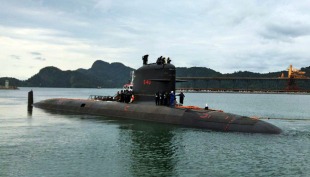Diesel-electric submarine S Riachuelo (S40)
Basic information
Ship measurements
Machine
- 4 * MTU 12V 396 SE84 diesels
- 1 * Jeumont-Schneider EPM Magtronic electric 3,909 hp (2,915 kW)
- 1 * shaft
Personnel
Combat assets
- DCNS Submarine Tactical Information and Command System
- Thales DR 3000 ESM receiver
- ITT AR 900
- TSM 2233 Eledone
- Safare & S-Cube
- DCNS Contralto-V
- 6 * 533 mm (21 in) torpedo tubes:
- 18 * F21 heavy torpedoes or
- 18 * SM-39 Exocet & MANSUP anti-ship missiles or
- 30 * naval mines
The Riachuelo (S40) is a Brazilian Riachuelo-class submarine built for the Brazilian Navy by DCNS in Cherbourg and ICN in Itaguaí, Brazil.
The Brazilian boats are larger in length, tonnage and cargo capacity compared to the original French Scorpène-class which they are derived of. The Brazilian version are 75 m (246 ft) and 2,000 tons, compared to the original Scorpènes that are 61.7 m (202 ft) and 1,565 tons.
In 2008, Brazil purchased four enlarged Scorpènes for US$9.9 billion with a total technology transfer agreement and a second agreement to develop the first Brazilian nuclear-powered submarine, Álvaro Alberto. The hull of Riachuelo was laid down at Cherbourg, France on 27 May 2010 and it was jumboized at the Brazilian Navy Shipyard in Itaguaí in late 2012.
Riachuelo was launched on 14 December 2018, and began sea trials in September 2019, the Humaitá was launched on 11 December 2020.
The first stage of construction of the submarine took place in France, at the headquarters of DCNS in Cherbourg, with the cutting of the first steel plates of the structure. At this point, technology transfer from French technicians to Brazilians began. In the middle of 2013, internal parts manufactured in France arrived, which were then integrated to the other parts built in Brazil. In September 2015, the first construction stage was completed, with the delivery of the last section of resistant hull.
The initial Navy predictions for the delivery of Riachuelo were for 2015, however, after some postponements, the boat was launched in 2018, in order to start the platform acceptance testing phase, with two years in duration, plus six months of tests of the combat systems, with its incorporation to the operative sector foreseen for the middle of 2021.
- Comments
 en
en ru
ru uk
uk



 Brazilian Navy
Brazilian Navy Itaguaí Construções Navais
Itaguaí Construções Navais Naval Group (formerly DCNS)
Naval Group (formerly DCNS)